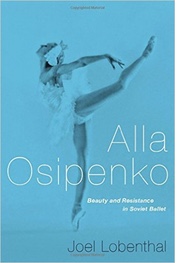I Spent Years Interviewing a Soviet Ballet Star for a Biography

"CroppedStalin1943" by U.S. Signal Corps photo. - http://hdl.loc.gov/loc.pnp/cph.3a33351. Licensed under Public Domain via Commons. "Vladimir Putin inauguration 7 May 2012-10" by Kremlin.ru. Licensed under CC BY 4.0 via Commons.
One of the final pupils of the great teacher Agrippina Vaganova, Alla Osipenko had entered then-Leningrad’s fabled Kirov Ballet in 1950. After Joseph Stalin died in 1953, cultural exchange between the Soviet Union and the West became a priority to both sides of the Iron Curtain. Osipenko had won great acclaim in Europe; she might have been appreciated as a valuable weapon in the USSR’s propaganda efforts. During the Kirov’s Paris debut in 1961, she had danced with Rudolf Nureyev the night before he defected. Like Nureyev, Osipenko had been too outspoken, too indiscreet, too willing to sample Western culture and thus not considered a good security risk by the Soviets. She had never joined the Communist Party. Eventually, she found her opportunities for foreign touring severely restricted. But Perestroika had made it possible for her to move here in 1995, when she was hired to teach in the school of the Hartford Ballet.
 I
came to know this extraordinary woman over forty interviews conducted
during a period of two-and-a-half years. I wrote about her for
the quarterly Ballet
Review,
and now, my biography has just been published. Today, with
Russian-U.S. relationship at low point, and many politicians
determined to provoke as much xenophobic hysteria as they can, my
memories of our many interviews are all the more something I
treasure. Raised in Stalin’s hyper-nationalistic and insular Soviet
Union, she had nothing of the nationalist in her.
I
came to know this extraordinary woman over forty interviews conducted
during a period of two-and-a-half years. I wrote about her for
the quarterly Ballet
Review,
and now, my biography has just been published. Today, with
Russian-U.S. relationship at low point, and many politicians
determined to provoke as much xenophobic hysteria as they can, my
memories of our many interviews are all the more something I
treasure. Raised in Stalin’s hyper-nationalistic and insular Soviet
Union, she had nothing of the nationalist in her.
Indeed, Osipenko had arrived here with what was in many ways an idealized vision of our country, shared by many of her fellow citizens. The more anti-US propaganda the government spewed, the more many Soviets, at least in the intelligentsia and arts communities, were convinced that America had to be a bastion of everything pure and just. “We thought America was a free country and so in America everything was beautiful, wonderful—no corruption.”
She once told me that a student of hers was going to a ballet competition. Someone familiar with it had told her that the results were going to be determined in advance. “Everybody knows who will be the first, number two, number three. It’s exactly the same as it is in Russia,” Osipenko complained.
It was always instructive to discuss with her contradictions, paradoxes complexities in the American national character. She liked it when she’d pass strangers on the street (this was not, after all, Manhattan), and they greeted her with a “Hi,” or “Good Morning!” Russians were much more closed. But she also said, as did other Russians of her generation, that the bonds of friendship went deeper there. “If you’re in trouble and you need help at any time of day or night, they’re there to help.” Was this really correct, I asked myself, perhaps foolishly, for we were, after all, dealing in impressions. Yet I think it’s true that the repression wielded by the Soviet state had brought bonds of resistance and cooperation as much as it atomized. Osipenko believed that generosity here in the U.S. was a more calculated quid pro quo: “Favors, you have to return the favor.”
Certainly, she was confounded by the Puritan streak remaining in the American consciousness. I met her as the Monica Lewinsky scandal was exploding. To Osipenko, the degree to which sexual peccadilloes could derail a politician’s career was astounding. “If I spoke English I’d be defending Clinton right now,” she told me. “It’s nobody’s damn business.”
Under the Soviets, religion was officially prohibited and art became a spiritual channel. It remained so in Russia , at least as far as Osipenko was concerned, well into the crisis-ridden years of the post-Perestroika 1990s. By the summer of 1998, Russian society fractured by the strain of its Western-advocated instant capitalism. Visiting Petersburg that summer, she saw her city roiling amid that year’s financial crisis. A contraction of public spheres meant that the safety net had been shredded. Art, however, seemed more essential than ever. She had seen James Cameron’s Titanic here, but took her grandson to watch it in Petersburg during her summer off in 1998. The rapt St. Petersburg audience impressed her.
In 2000, Osipenko returned permanently to St. Petersburg, motivated in part by the desire to be with her grandson. Leaving America, she showed me a letter from ex-Hartford Ballet director Kirk Peterson. “What an inspiration you were to me, to the company, and to everyone.” At a farewell party in Hartford, she also expressed gratitude for the help she had been given during any number of crises of adjustment with her new life here. She told me during one of our last interviews that ultimately she believed that her students had understood her and she had understood them.
What overarching lesson might be drawn from a life as long—she is now eighty-three---complex and full of incident as Osipenko’s? For me, amid today’s geopolitical tensions and hostilities, I would have to say that her life, her personality, her career validate not simply the importance but the necessity of dialogue, tolerance, cooperation between cultures, societies, governments. And, of course, between studios, schools and troupes of ballet!
